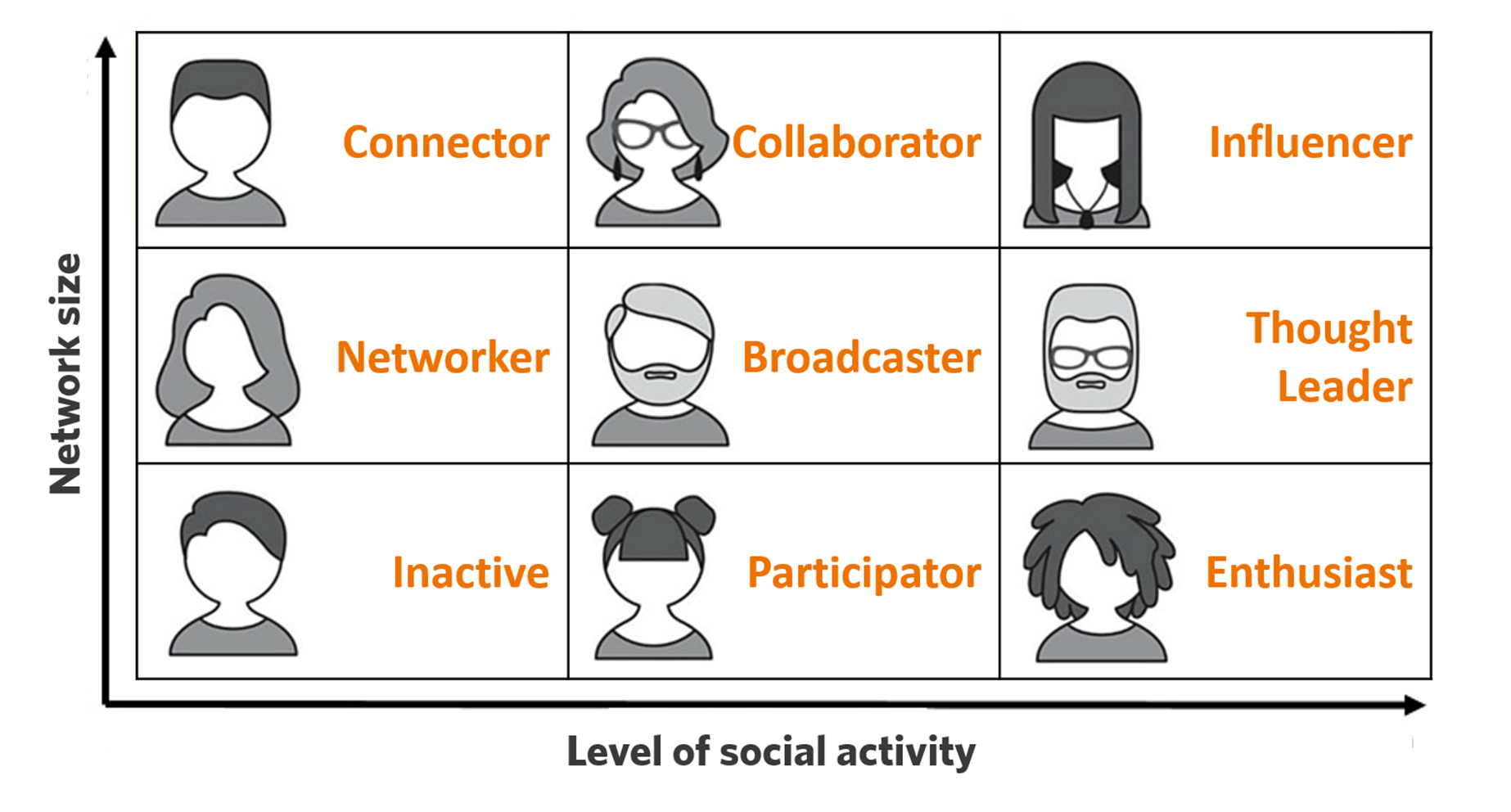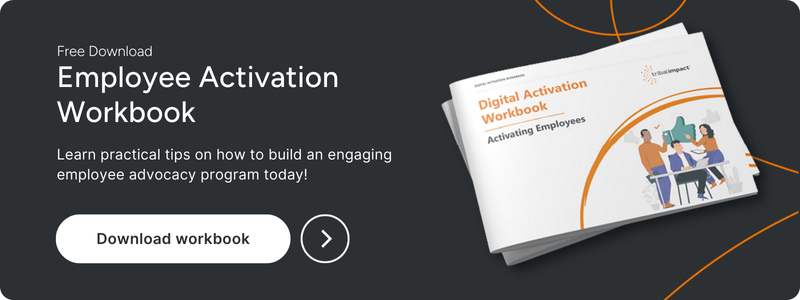Getting employees to become advocates sounds like a great idea. 98% of your employees are already using social media, and 50% are already talking about your business on there (Weber Shandwick). Why not take advantage of those numbers?
Even with numbers like that, it doesn’t always turn out how we’d planned. Employees can start becoming advocates, then get bored, or confused, or not know what’s expected of them. There are lots of barriers that can demotivate employees when it comes to being employee advocates.
It’s important to identify these barriers so that you can motivate them to become advocates and inspire them to keep going and not get bored.
Barriers can include:
- Fear
- Uninteresting content to share
- Lack of data
- Lack of maturity
Let’s take a look at these barriers in more depth, and explore how you can overcome them to motivate employees to engage with your employee advocacy programme.
They’re At The Wrong Stage Of Maturity
Our Social Business Maturity Model helps you understand where your employees are within the nine stages of maturity on social media. This can help you work out where employees are now, and where they could progress to with the right training.

Here’s what you should be looking for to identify employees you could advance further:
- Are they active? And, if they’re inactive, is it because they’re uninterested or because they lack confidence?
- Do they have an ad-hoc approach? Is this because of lack of confidence, lack of interest, or a need for more targeted training?
- Do they just post promotional content? Is this because of misdirected enthusiasm, or do they see it as a box-ticking exercise?
- Are they collaborative and/or enthusiastic? These employees show the most interest and have the most promise. Find out what their goals are – is it to become a Thought Leader or Industry Influencer?
Once you know someone’s maturity level, you can take steps to support their growth as an advocate.
Nobody Understands Your Social Media Policy
Even if an employee is in an advanced stage of the model, if they don’t know what’s expected of them when they post on social media, they’re less likely to be advocates.
Our recent Employee Social Media Risk Report 2021 showed that 42% of employees aged 18-34 have read and not understood, never read, or don’t even know about, their company’s social media policy.
If an employee doesn’t know what’s expected of them, they’re less likely to do something and more likely to make mistakes.
A clear social media policy written in plain English is therefore important for encouraging and supporting employees.
It can help to make the policy memorable and visually appealing. If it’s easier to refer to, employees are more likely to use it when they need it.
Also, include someone’s contact details in the policy so that employees know who to speak to if they have any questions, or if they spot anything questionable that’s been posted about the brand online.
It can also help to include guidelines and examples. This helps employees to really visualise what’s expected of them and how to handle different situations.
They Need Training
Before some employees can truly excel at advocacy, they may need training first. Businesses can provide training and demos on just about any aspect they feel employees could benefit from, whether that’s more basic things like how to use a platform, or something more advanced. One thing is certain though, you can’t use a blanket approach towards training your employees as some will be more advanced than others.
Some topics that may be useful include how to reply to negative comments, optimising their LinkedIn profile, relevant hashtags they could use, sharing InMail connection request examples, or showing them what a great post hook looks like.
The more brands expose employees to the right type of content, the easier it will be for them to emulate it. That’s why training, and getting more mature employees to join in first, is so important.
Fear Of Sharing Content
Fear holds us back from many things in life, and content sharing is no exception.
Employees may be worried about getting judged for the content they share, or worry that people won’t care what they have to say. They may even feel embarrassed at putting themselves and their voice out there.
A training program which mitigates these fears, and shows the real benefits of employee advocacy, can go a long way to supporting employees face this barrier.
Offering continued moral support may also help employees who are particularly anxious. This could come in the form of some sort of buddy system, or mentoring from more senior employee advocates.
You’re Using The Wrong Tool
For an employee to embrace employee advocacy, they need to understand how to use your chosen employee advocacy tool. If they don’t, they’re less likely to login and share content.
Providing targeted training can really help with this. This can be used to show how the tool works, explain when it’s updated, what to do when it’s updated, and answer any other questions employees might have.
The lower the barrier to entry is for advocacy, the more employees who will be willing to embrace it. If a tool looks complicated, it will immediately put them off in favour of doing other aspects of their job. The more you can make advocacy feel like a fun, simple addition to their current role, the more likely they’ll be to join in.
They Dislike The Content In Your Advocacy Tool
Any advocacy tool is only as good as the content in it. Businesses need a lot of content, on a range of topics, to get as many employees as possible to engage.
Aim to cover 8-12 topics in the content on offer. This gives enough variety that there’ll be something for everyone to share, without content curators feeling overwhelmed by how much time they have to spend finding new content to add to it.
How much content you can feed into a tool at any time depends on the tool and your budget, but ideally you want to be adding 3-5 new pieces of content each day.
Advocates should be sharing around 60% curated content, 30% of their own content, and 10% promotional content.
They Don’t Know What To Write
Part of any great advocacy program is employee-generated content. As mentioned above, we recommend 30% of content should be written by your advocates.
Not everyone is a confident writer, though. Or they don’t enjoy writing because they disliked English at school.
This is where setting examples can be really powerful. Show employees the writing style you want them to use, whether that’s the brand voice or their own.
If they struggle to write, they could try dictation. What comes out will sound more natural, particularly to employees who aren’t regular writers. Dictation can also remove barriers such as overthinking for some people.
You could also put together an idea generation session, or teach employees how to generate ideas themselves. Give them a timer – no more than five minutes – then ask them to write down as many ideas as possible related to the business, their role, their area of expertise, and peripheral topics their audience may find useful. It’s important they do this without filter – hence the timer – because it will build their confidence in their own ideas.
Once they’ve done that, they can go through the ideas and choose the ones they’d like to write about in their content.
Leadership Aren’t Setting An Example
If leadership doesn’t see the benefits of social selling, that will have a ripple effect on to employees. Why should anyone bother with something that C-Suite doesn’t see as beneficial?
When leadership teams are on board, it shows that they value employee advocacy, and it’s more than just a passing trend. Employees trust the judgment of higher-ups, so if they show commitment and enthusiasm towards something, employees will follow suit.
Sometimes, all it takes is one member of the leadership team to undergo some training and get a proper understanding of employee advocacy. This can make them see the real power behind it and make them want to try it for themselves. They can then go away and share their experience with the rest of the team and encourage them to give it a chance, too.
Conclusion
Motivating employees to take part in employee advocacy can be one of the biggest challenges businesses face when implementing an advocacy program. But, if you can overcome these challenges, you’re on track to a powerful employee advocacy program.
